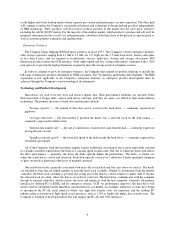Western Digital 1998 Annual Report Download - page 21
Download and view the complete annual report
Please find page 21 of the 1998 Western Digital annual report below. You can navigate through the pages in the report by either clicking on the pages listed below, or by using the keyword search tool below to find specific information within the annual report.
16
Item 7. Management's Discussion and Analysis of Financial Condition and Results of Operations
Overview
Western Digital is a leading supplier of hard drives for desktop and enterprise computers. The hard drive industry
is intensely competitive and has experienced a great deal of growth, entry and exit of firms, and technological change
over the past several years. This industry is characterized as a high-tech commodity business with short product life
cycles, dependence upon highly skilled engineering and other personnel, significant expenditures for product
development and recurring periods of under and over supply.
The Company's operating results during 1998 deteriorated primarily as a result of increased competition,
particularly in the desktop storage market, and operating issues resulting from an accelerated transition from thin film
recording head technology to MR head technology. Although the business environment was challenging in 1998, the
Company continued to invest significantly in its desktop and enterprise hard drive businesses.
In June 1998, the Company entered into a broad-based hard drive component supply and technology licensing
agreement with IBM ("IBM Agreement") for its desktop PC products. As a result of the IBM Agreement, the Company
expects to begin shipping desktop hard drives featuring GMR heads in the first six months of calendar 1999. The
Company anticipates that these hard drives will augment Western Digital's product offerings thereby improving its
competitiveness in terms of time-to-market, time-to-capacity and cost.
The Company has invested heavily in its enterprise storage business over the past few years and has built its share
of this market to approximately 8% as of the end of 1998. The Company is planning a significant increase in its
research and development spending during 1999 to transform Western Digital into a full-line supplier of enterprise
hard drives by the middle of 2000. The Company expects that having a full product line will help attract new OEM
customers, thereby increasing sales and operating profit.
Results of Operations
Comparison of 1996, 1997 and 1998
In 1996, the Company reported net income of $96.9 million compared with net income of $267.6 million for 1997
and a net loss of $290.2 million for 1998. The increase in operating income from 1996 to 1997 resulted from a 46%
increase in revenues, a two percentage point increase in gross margin, and a two percentage point decline in operating
expenses as a percentage of revenues. The deterioration in operating performance from 1997 to 1998 occurred
because of a 15% decrease in revenues, a 13 percentage point decline in gross profit margin and a three percentage
point increase in operating expenses as a percentage of revenues. Net income for 1996 included a one-time, pre-tax
gain of $17.3 million on the sale of the Company's multimedia products business. The net loss in 1998 included
special charges of $148 million recorded in the second quarter, primarily to cost of sales, and $22 million of costs
recorded in the fourth quarter to research and development ("R&D") principally related to the start-up of the IBM
Agreement. The $148 million of special charges include estimated component cancellation charges, inventory and
other asset write-downs, costs incurred on terminated mobile PC engineering programs, and other estimated
incremental costs related to the production, sale, and accelerated wind-down of thin film products and ramp-up of
products with MR heads.
Sales of hard drive products were $2.8, $4.2 and $3.5 billion in 1996, 1997 and 1998, respectively. Beginning in
1997, 100% of the Company's revenues were generated from the sale of hard drive products. Unit shipments increased
51% from 1996 to 1997, but declining average selling prices ("ASP") reduced the 1996 to 1997 hard drive revenue
growth rate to 49%. The higher unit volume in 1997 primarily resulted from increased business with OEMs and, to a
lesser extent, incremental unit shipments to resellers. Also in 1997, the Company began shipping products from its
enterprise storage product line. During 1998, unit shipments decreased 6% which, combined with reductions in the
ASPs of hard drive products due to an intensely competitive hard drive business environment, resulted in a 15%
decline in hard drive revenues from 1997.
Gross profit margins were as follows:
























